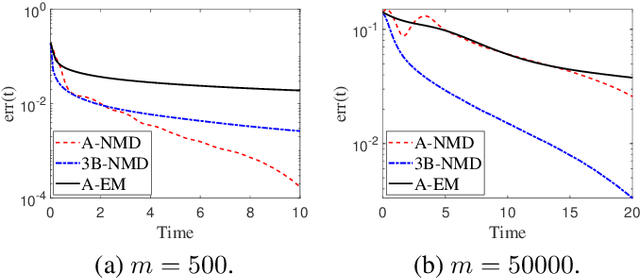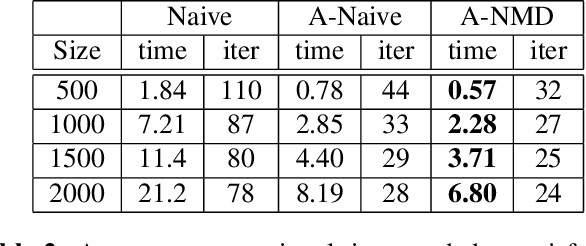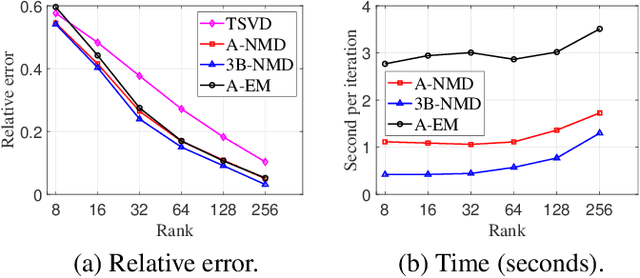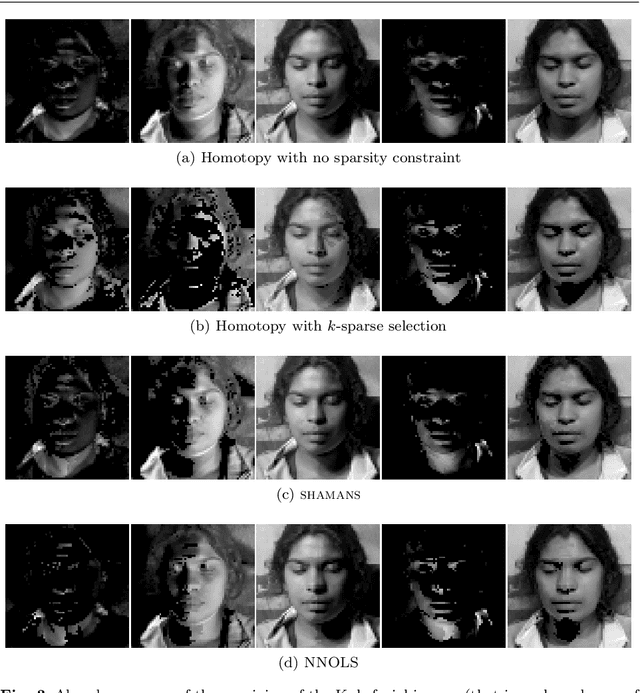Arnaud Vandaele
Efficient algorithms for the Hadamard decomposition
Apr 22, 2025



Abstract:The Hadamard decomposition is a powerful technique for data analysis and matrix compression, which decomposes a given matrix into the element-wise product of two or more low-rank matrices. In this paper, we develop an efficient algorithm to solve this problem, leveraging an alternating optimization approach that decomposes the global non-convex problem into a series of convex sub-problems. To improve performance, we explore advanced initialization strategies inspired by the singular value decomposition (SVD) and incorporate acceleration techniques by introducing momentum-based updates. Beyond optimizing the two-matrix case, we also extend the Hadamard decomposition framework to support more than two low-rank matrices, enabling approximations with higher effective ranks while preserving computational efficiency. Finally, we conduct extensive experiments to compare our method with the existing gradient descent-based approaches for the Hadamard decomposition and with traditional low-rank approximation techniques. The results highlight the effectiveness of our proposed method across diverse datasets.
Algorithms for Boolean Matrix Factorization using Integer Programming
May 17, 2023



Abstract:Boolean matrix factorization (BMF) approximates a given binary input matrix as the product of two smaller binary factors. As opposed to binary matrix factorization which uses standard arithmetic, BMF uses the Boolean OR and Boolean AND operations to perform matrix products, which leads to lower reconstruction errors. BMF is an NP-hard problem. In this paper, we first propose an alternating optimization (AO) strategy that solves the subproblem in one factor matrix in BMF using an integer program (IP). We also provide two ways to initialize the factors within AO. Then, we show how several solutions of BMF can be combined optimally using another IP. This allows us to come up with a new algorithm: it generates several solutions using AO and then combines them in an optimal way. Experiments show that our algorithms (available on gitlab) outperform the state of the art on medium-scale problems.
Accelerated Algorithms for Nonlinear Matrix Decomposition with the ReLU function
May 15, 2023



Abstract:In this paper, we study the following nonlinear matrix decomposition (NMD) problem: given a sparse nonnegative matrix $X$, find a low-rank matrix $\Theta$ such that $X \approx f(\Theta)$, where $f$ is an element-wise nonlinear function. We focus on the case where $f(\cdot) = \max(0, \cdot)$, the rectified unit (ReLU) non-linear activation. We refer to the corresponding problem as ReLU-NMD. We first provide a brief overview of the existing approaches that were developed to tackle ReLU-NMD. Then we introduce two new algorithms: (1) aggressive accelerated NMD (A-NMD) which uses an adaptive Nesterov extrapolation to accelerate an existing algorithm, and (2) three-block NMD (3B-NMD) which parametrizes $\Theta = WH$ and leads to a significant reduction in the computational cost. We also propose an effective initialization strategy based on the nuclear norm as a proxy for the rank function. We illustrate the effectiveness of the proposed algorithms (available on gitlab) on synthetic and real-world data sets.
A Homotopy-based Algorithm for Sparse Multiple Right-hand Sides Nonnegative Least Squares
Nov 24, 2020



Abstract:Nonnegative least squares (NNLS) problems arise in models that rely on additive linear combinations. In particular, they are at the core of nonnegative matrix factorization (NMF) algorithms. The nonnegativity constraint is known to naturally favor sparsity, that is, solutions with few non-zero entries. However, it is often useful to further enhance this sparsity, as it improves the interpretability of the results and helps reducing noise. While the $\ell_0$-"norm", equal to the number of non-zeros entries in a vector, is a natural sparsity measure, its combinatorial nature makes it difficult to use in practical optimization schemes. Most existing approaches thus rely either on its convex surrogate, the $\ell_1$-norm, or on heuristics such as greedy algorithms. In the case of multiple right-hand sides NNLS (MNNLS), which are used within NMF algorithms, sparsity is often enforced column- or row-wise, and the fact that the solution is a matrix is not exploited. In this paper, we first introduce a novel formulation for sparse MNNLS, with a matrix-wise $\ell_0$ sparsity constraint. Then, we present a two-step algorithm to tackle this problem. The first step uses a homotopy algorithm to produce the whole regularization path for all the $\ell_1$-penalized NNLS problems arising in MNNLS, that is, to produce a set of solutions representing different tradeoffs between reconstruction error and sparsity. The second step selects solutions among these paths in order to build a sparsity-constrained matrix that minimizes the reconstruction error. We illustrate the advantages of our proposed algorithm for the unmixing of facial and hyperspectral images.
Sparse Separable Nonnegative Matrix Factorization
Jun 13, 2020



Abstract:We propose a new variant of nonnegative matrix factorization (NMF), combining separability and sparsity assumptions. Separability requires that the columns of the first NMF factor are equal to columns of the input matrix, while sparsity requires that the columns of the second NMF factor are sparse. We call this variant sparse separable NMF (SSNMF), which we prove to be NP-complete, as opposed to separable NMF which can be solved in polynomial time. The main motivation to consider this new model is to handle underdetermined blind source separation problems, such as multispectral image unmixing. We introduce an algorithm to solve SSNMF, based on the successive nonnegative projection algorithm (SNPA, an effective algorithm for separable NMF), and an exact sparse nonnegative least squares solver. We prove that, in noiseless settings and under mild assumptions, our algorithm recovers the true underlying sources. This is illustrated by experiments on synthetic data sets and the unmixing of a multispectral image.
Near-Convex Archetypal Analysis
Oct 02, 2019



Abstract:Nonnegative matrix factorization (NMF) is a widely used linear dimensionality reduction technique for nonnegative data. NMF requires that each data point is approximated by a convex combination of basis elements. Archetypal analysis (AA), also referred to as convex NMF, is a well-known NMF variant imposing that the basis elements are themselves convex combinations of the data points. AA has the advantage to be more interpretable than NMF because the basis elements are directly constructed from the data points. However, it usually suffers from a high data fitting error because the basis elements are constrained to be contained in the convex cone of the data points. In this letter, we introduce near-convex archetypal analysis (NCAA) which combines the advantages of both AA and NMF. As for AA, the basis vectors are required to be linear combinations of the data points and hence are easily interpretable. As for NMF, the additional flexibility in choosing the basis elements allows NCAA to have a low data fitting error. We show that NCAA compares favorably with a state-of-the-art minimum-volume NMF method on synthetic datasets and on a real-world hyperspectral image.
Coordinate Descent Methods for Symmetric Nonnegative Matrix Factorization
May 31, 2016



Abstract:Given a symmetric nonnegative matrix $A$, symmetric nonnegative matrix factorization (symNMF) is the problem of finding a nonnegative matrix $H$, usually with much fewer columns than $A$, such that $A \approx HH^T$. SymNMF can be used for data analysis and in particular for various clustering tasks. In this paper, we propose simple and very efficient coordinate descent schemes to solve this problem, and that can handle large and sparse input matrices. The effectiveness of our methods is illustrated on synthetic and real-world data sets, and we show that they perform favorably compared to recent state-of-the-art methods.
* 25 pages, 5 figures, 7 tables. Main changes: comparison with another symNMF algorithm (namely, BetaSNMF), and correction of an error in the convergence proof
Heuristics for Exact Nonnegative Matrix Factorization
Nov 26, 2014



Abstract:The exact nonnegative matrix factorization (exact NMF) problem is the following: given an $m$-by-$n$ nonnegative matrix $X$ and a factorization rank $r$, find, if possible, an $m$-by-$r$ nonnegative matrix $W$ and an $r$-by-$n$ nonnegative matrix $H$ such that $X = WH$. In this paper, we propose two heuristics for exact NMF, one inspired from simulated annealing and the other from the greedy randomized adaptive search procedure. We show that these two heuristics are able to compute exact nonnegative factorizations for several classes of nonnegative matrices (namely, linear Euclidean distance matrices, slack matrices, unique-disjointness matrices, and randomly generated matrices) and as such demonstrate their superiority over standard multi-start strategies. We also consider a hybridization between these two heuristics that allows us to combine the advantages of both methods. Finally, we discuss the use of these heuristics to gain insight on the behavior of the nonnegative rank, i.e., the minimum factorization rank such that an exact NMF exists. In particular, we disprove a conjecture on the nonnegative rank of a Kronecker product, propose a new upper bound on the extension complexity of generic $n$-gons and conjecture the exact value of (i) the extension complexity of regular $n$-gons and (ii) the nonnegative rank of a submatrix of the slack matrix of the correlation polytope.
* 32 pages, 2 figures, 16 tables
 Add to Chrome
Add to Chrome Add to Firefox
Add to Firefox Add to Edge
Add to Edge